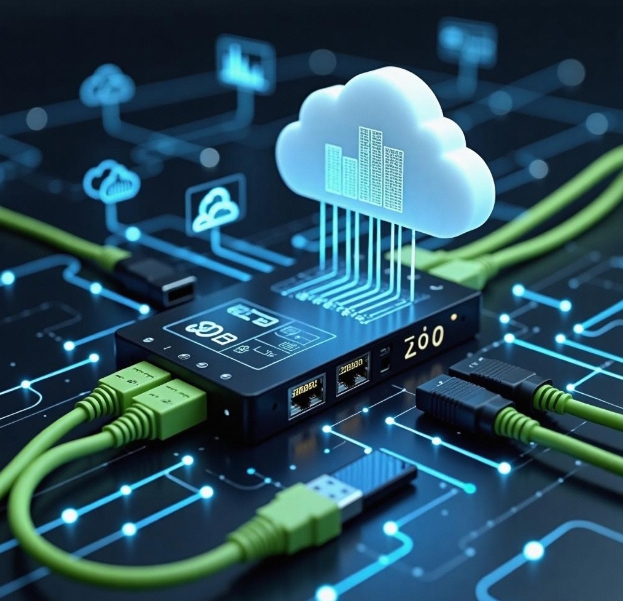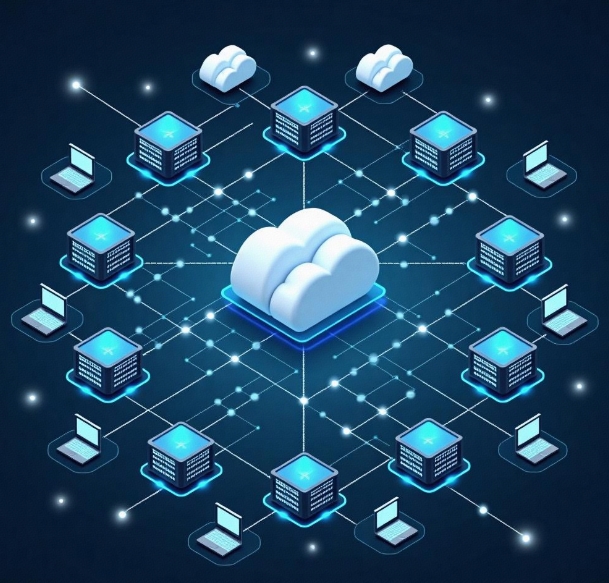Integration of Cloud Computing and Artificial Intelligence: Optimizing Application Experience
- latest articles
- 1.DApp Development & Customization: Merging Diverse Market Needs with User Experience 2.Analysis of the Core Technical System in DApp Project Development 3.How to achieve cross-chain interoperability in Web3 projects? 4.How does the tokenization of points reconstruct the e-commerce ecosystem? 5.How to Set and Track Data Metrics for a Points Mall? 6.What is DApp Development? Core Concepts and Technical Analysis 7.Inventory of commonly used Web3 development tools and usage tips 8.Development of a Distribution System Integrated with Social E-commerce 9.Six Key Steps for Businesses to Build a Points Mall System 10.What is DApp Development? A Comprehensive Guide from Concept to Implementation
- Popular Articles
- 1.Future Trends and Technology Predictions for APP Development in 2025 2.Analysis of the DeFi Ecosystem: How Developers Can Participate in Decentralized Finance Innovation 3.From Zero to One: How PI Mall Revolutionizes the Traditional E-commerce Model 4.DAPP Development | Best Practices for Professional Customization and Rapid Launch 5.Recommended by the Web3 developer community: the most noteworthy forums and resources 6.From Cloud Computing to Computing Power Leasing: Building a Flexible and Scalable Computing Resource Platform 7.How to Develop a Successful Douyin Mini Program: Technical Architecture and Best Practices 8.Shared Bike System APP: The Convenient Choice in the Era of Smart Travel 9.How to Create a Successful Dating App: From Needs Analysis to User Experience Design 10.From Design to Development: The Complete Process of Bringing an APP Idea to Life
In today's rapidly evolving technological landscape, the integration of cloud computing and artificial intelligence (AI) has become a significant driver of innovation and business transformation. Cloud computing provides elastic and scalable computational resources, while AI offers powerful algorithmic support for data analysis, intelligent decision-making, and automated tasks. When these two technologies converge, they not only significantly enhance application performance but also optimize user experiences, enabling more efficient and intelligent services. This article explores how the fusion of cloud computing and AI optimizes application experiences across various fields and looks ahead to future development trends.
Basic Concepts of Cloud Computing and Artificial Intelligence
Definition and Characteristics of Cloud Computing
Cloud computing is a method of delivering computing services over the internet, typically including storage, computational power, and software applications. Through an on-demand self-service model, it allows users to pay only for the resources they use, thereby reducing IT costs for businesses. Key characteristics of cloud computing include elastic scalability, high availability, resource sharing, and efficient resource utilization through multi-tenancy models.
Definition and Development of Artificial Intelligence
Artificial intelligence refers to technology that mimics human intelligence activities through machines, including learning, reasoning, and problem-solving. AI has made significant progress in various fields, from autonomous vehicles to intelligent voice assistants and deep learning algorithms. Its applications continue to expand and permeate all aspects of our lives.
Integration of Cloud Computing and Artificial Intelligence
With the widespread adoption of cloud computing technology and the rapid development of AI, their integration has become a crucial force driving technological innovation and business transformation. Cloud computing provides massive data storage and computational capabilities, while AI delivers more intelligent services through data analysis and machine learning. The combination of these two enables businesses to utilize resources more efficiently, reduce development costs, and accelerate innovation.
Application Optimization Brought by the Integration of Cloud Computing and AI
1. Enhancing Application Performance and Response Speed
The combination of cloud computing and AI enables real-time processing of massive data through powerful cloud-based computational capabilities, significantly improving application performance. Traditional applications are often limited by local hardware processing power, but with cloud computing platforms, applications can dynamically allocate computational resources based on demand, optimizing response speed and user experience.
For example, in e-commerce platforms, cloud computing provides robust data processing capabilities for product recommendations, while AI analyzes user behavior data to generate personalized recommendation lists. This integration allows recommendation systems to respond quickly to user needs, enhancing user satisfaction and boosting sales.
2. Achieving Personalized Services
Personalization is a key direction in modern application development. AI's machine learning capabilities can analyze users' historical behaviors, preferences, and needs, providing tailored services based on this data. Through cloud platforms, businesses can leverage vast amounts of data and high-performance computational resources for in-depth analysis, delivering more accurate recommendations and intelligent services to users.
For instance, video streaming platforms like Netflix or YouTube use AI to analyze user viewing habits and, with cloud computing support, provide personalized content recommendations. This not only increases user engagement but also enhances platform revenue streams.
3. Intelligent Data Processing and Analysis
Cloud computing provides powerful computational resources for big data analysis, while AI, through deep learning algorithms, can extract valuable insights from complex datasets. In many industries, this combination significantly improves the efficiency and accuracy of data analysis, offering robust decision-making support for businesses.
For example, in the healthcare industry, AI combined with cloud computing can analyze medical records, genetic data, and medical images, using deep learning algorithms to help doctors diagnose diseases more quickly and accurately. This intelligent data processing not only enhances the quality of medical services but also substantially reduces the time required for manual diagnosis.
4. Automation and Intelligent Operations
The integration of cloud computing and AI also drives the realization of intelligent automation. Through cloud platforms, businesses can implement automated operations, reducing human intervention and errors while improving work efficiency. AI continuously optimizes workflows through self-learning capabilities, enabling automated systems to handle more complex tasks.
Take intelligent customer service as an example: many businesses have already established automated customer service systems using cloud platforms and AI technology. These systems can handle customer inquiries 24/7 without interruption and provide interactions similar to human customer service through natural language processing (NLP) technology. As AI technology continues to evolve, future intelligent customer service will become even smarter, capable of handling more complex issues and delivering more precise responses.
Challenges and Solutions in the Integration of Cloud Computing and AI
Although the integration of cloud computing and AI brings many benefits, there are still some challenges in practical applications.
1. Data Privacy and Security Issues
As the volume of data stored on cloud platforms increases, data privacy and security become particularly important. Especially since AI requires large amounts of data to train models, this data may involve sensitive content such as users' personal information and medical records. How to fully utilize this data while ensuring data privacy and security is a challenge in current technological development.
To address this issue, many cloud service providers are strengthening security measures such as data encryption, identity verification, and access control. Additionally, privacy-preserving algorithms for AI models (such as differential privacy techniques) are continuously evolving to ensure the security of user data.
2. High Cost of Computational Resources
Artificial intelligence, especially the training of deep learning models, requires substantial computational resources, which can lead to significant costs for businesses on cloud platforms. Although the pay-as-you-go model of cloud computing reduces initial investments, cost remains a non-negligible issue during long-term, large-scale usage.
To tackle this problem, cloud service providers are continuously improving the cost-effectiveness of computational resources, introducing more flexible billing models, and reducing computational costs by optimizing hardware infrastructure (such as adopting dedicated AI accelerators).
3. Technology and Talent Shortage
AI technology itself has a high technical barrier, and businesses often require specialized technical teams when applying AI in cloud computing environments. This poses a talent shortage challenge for many small and medium-sized enterprises adopting AI. To address this challenge, companies can bridge the technical gap through outsourcing, partnerships, or investing in training.
Future Outlook: Deep Integration of Cloud Computing and AI
With the development of technologies such as 5G, the Internet of Things (IoT), and edge computing, the integration of cloud computing and AI will deepen further. Future applications will become more intelligent, capable of responding to user needs in real-time and providing customized services. Meanwhile, the combination of AI and cloud computing will play a vital role in the digital transformation of various industries, helping businesses achieve innovation and growth.
1. Integration of Edge Computing and Cloud AI
Edge computing is a computational approach that shifts data processing and storage from the cloud to the network edge. With the advancement of 5G technology, edge computing will become a key direction in the integration of cloud computing and AI. Edge computing reduces latency and increases data processing speed, enabling AI algorithms to respond to user needs more quickly.
2. Deep Integration of AI and Automation
In the future, AI will further penetrate automated workflows, especially in industries such as manufacturing, logistics, and healthcare. Cloud platforms will provide these industries with robust data processing and computational support, while AI, through machine learning and data analysis, will help businesses achieve more intelligent automated operations.
Conclusion
The integration of cloud computing and artificial intelligence is undoubtedly at the forefront of technological innovation. Their combination not only enhances application performance and response speed but also drives advancements in personalized services, intelligent operations, and data analysis. Despite challenges such as data security, costs, and talent shortages, with continuous technological progress and optimized solutions, the fusion of cloud computing and AI will play an increasingly important role in future digital transformation, helping businesses improve user experiences and create more commercial value.
-

Applications and Challenges of Cloud Computing in the Internet of Things (IoT)
With the continuous advancement of information technology, cloud computing and t···
-

Integration of Cloud Computing and Artificial Intelligence: Enhancing Intelligent Applications
With the rapid advancement of technology, cloud computing and artificial intelli···
-

Data Security and Privacy Protection in Cloud Computing Applications
With the continuous advancement of information technology and the rapid developm···

 Blockchain
Blockchain












